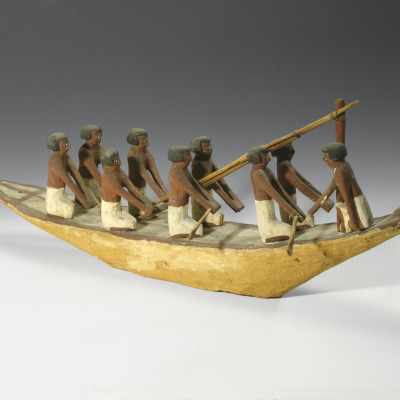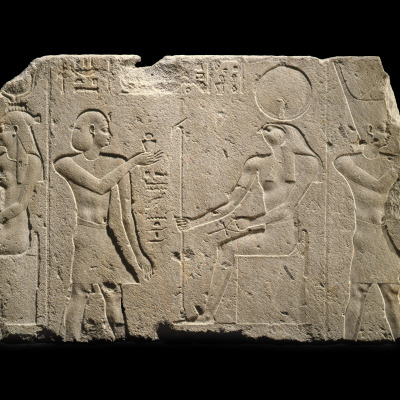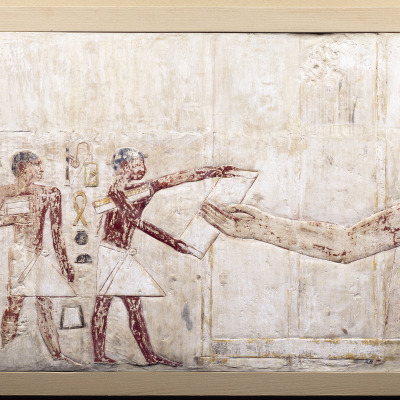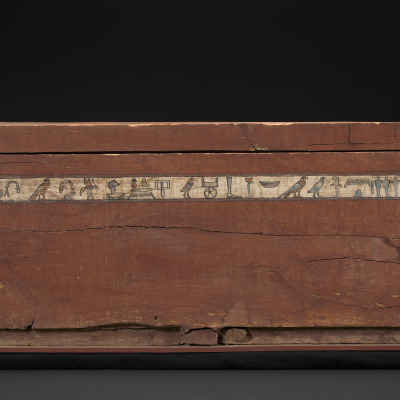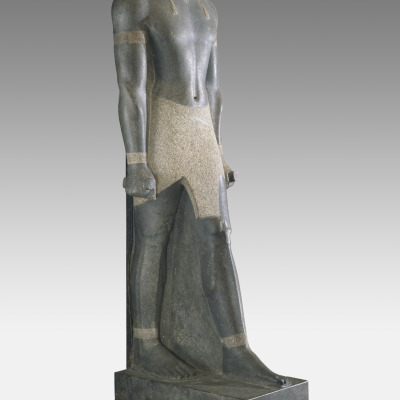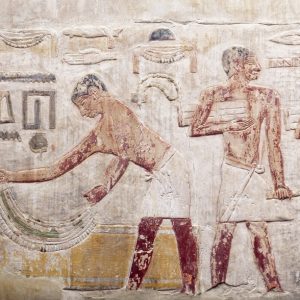
Egypt: Interactive Exploration
Who were the ancient Egyptians? Explore objects from ancient Egypt to discover how the Egyptians lived and what they believed.
Reflection
Before you begin your exploration, take a few minutes to think about these questions:
- When you think of ancient Egypt, what words or images come to mind?
- What do you hope to learn about ancient Egypt? Write down 2-3 questions you have about ancient Egypt.
Egypt and the Nile
Egypt is the home of one of the world’s earliest civilizations! More than five thousand years ago, this great civilization began to take shape in the northeast corner of Africa.
This image of Egypt was taken by a satellite in space. Take a few moments to look closely and think about the following questions before you read the information below.
- Describe the natural environment. What might the weather be like? What kind of plants and animals do you think live here?
- Where do you think the ancient Egyptians lived? Why do you think that is?

Jacques Descloitres, MODIS Rapid Response Team, NASA/sh / Public domain
Ancient Egypt was surrounded by natural borders: deserts to the east and west and the vast Mediterranean Sea to the north. The Egyptians lived along the Nile River, which flowed north to south. The Nile River flooded every year, bringing rich dark soil that was ideal for farming fruits, vegetables and wheat. The Egyptians called their land kemet, which meant black land, after that fertile dark soil. The Nile was the source of life for the ancient Egyptians. This cycle of flooding, crop growth, death, and regrowth helped define many aspects of daily life, including the calendar, work, transportation, food, and religion.
Boat Model, 2010-1961 BC, Egyptian, wood coated with plaster, painted, Adolph D. and Wilkins C. Williams Fund, 53.30.3
The Egyptian People
Egyptian society was organized in a hierarchy, meaning that people were ranked based on their job and wealth. At the top of the hierarchy was the king, sometimes called the pharaoh. The job of the king was to maintain ma’at, a word meaning truth, order, and balance. To do this, the king made laws, fought against foriegn invaders, and built temples for the gods. Under the king were his chosen advisors and priests who helped him in his quest for balance. The rest of the people had jobs such as farmers, carpenters, fishermen, sculptors, and countless others. Everyone in Egyptian society was important and valued because they were all a part of ma’at.
Click on the pop-up hot spots on this relief to learn how the king kept balance between humans and the gods. Then, think about these questions:
- What might have happened if the king did not do his job to keep balance?
- How do you think everyone in Egypt contributed to the balance of their society?
- What does the Egyptian concept of ma’at mean to you?
Royal Figure Making Offerings to a Deity, ca. 350 BC, Egyptian, red granite, Adolph D. and Wilkins C. Williams Fund63.45
Egyptian Art
What today might be just considered art was originally created to serve many different purposes in Egyptian life. Many objects, carvings, and paintings had religious or magical functions. Ancient Egyptian art reveals beliefs about the world and the ancient Egpytian’s attempts to understand it.
Tomb Relief, 2475-2195 BC, Egyptian, limestone, pigments, Adolph D. and Wilkins C. Williams Fund, 55.6.2
Hieroglyphs
The Egyptians were one of the first cultures to invent writing. They used symbols called hieroglyphs for sounds, words, and ideas. There are over seven hundred hieroglyphs! The ancient Egyptians called their writing medu-netjer, which means “words of god,” because they believed that the god Thoth invented writing.
Fragment of a Mythological Papyrus Scroll, 975-950 BC, Egyptian, papyrus, tempera, Adolph D. and Wilkins C. Williams Fund, 54.10
The Afterlife
Ancient Egyptians believed that after people die in this world, they continue living in another world. Bodies were preserved, or protected, through mummification, a very long and expensive process that not everyone could afford. Mummies were wrapped and placed in coffins and buried in tombs or graves. Magic spells and special instructions were often written in hieroglyphs on coffins and in tombs to offer protection and ward off evil. Protective amulets, similar to lucky charms, were also sometimes wrapped with the mummy.
Click on the pop-up hot spots to learn about this coffin and the person it belonged to. Then, think about these questions.
- Mummification was expensive. Who in Egyptian society do you think could afford this process? Who was left out?
- Why might the Egyptians believe people needed protection in the afterlife?
In the afterlife, the dead still required objects from their daily life. Objects such as vessels for storing food, sandals, and even games were placed with the dead for use in the afterlife.
- What objects would you expect to find in Tjeby’s tomb? In a king’s tomb? What objects would you take to the afterlife?
Coffin and Mummy of Tjeby, 2051-230 BC, Egyptian, painted wood with linen wrapped mummy, Adolph D. and Wilkins C. Williams Fund, 53.30.1
Egypt’s Southern Neighbor
Nubia was a region of Africa located south of Egypt in what is now the country of Sudan. Long ago Nubia was the home of the Kingdom of Kush. Like the Egyptians, Nubians lived along the Nile River, growing such foods as grain, peas, lentils, and dates. In the desert areas, they mined carnelian and other precious stones as well as metals such as gold. The Kushites traded these resources with the Egyptians for grain, vegetable oils, wine, beer, linen, and other goods. The Kushites and the Egyptians were sometimes peaceful and sometimes hostile neighbors. From 760 to 656 BC, the Kushites ruled Egypt, and King Senkamanisken ruled Kush soon after this time.
The influence these two cultures had one each other can be seen in art, like this statue. Click on the pop-up hot spots to learn more about the statue and use it to answer these questions.
- What might have happened to the gold that covered the statue?
- Why do you think Nubia wanted to copy Egypt’s artistic style?
- Stand up and copy the King’s pose. What does it feel like? This statue is missing his head, but what facial expression do you think he was making?
Statue of Senkamanisken, King of Kush, 643- 623 BC, Egyptian, gray-black granite, Adolph D. and Wilkins C. Williams Fund, 53.30.2
Egypt is in Africa
Although the Sahara Desert separated ancient Egypt from the rest of Africa, the people of this multicultural continent traded with each other across long distances and shared many common ideas and beliefs.
Click on the pop-up hot spots on this map of Africa to see different objects from the VMFA collection.
- What similarities do you see between these objects and the ancient Egyptian objects?
- What differences do you see?
Egyptomania!
Egyptomania, or “madness for Egypt,” describes the fascination that has inspired artists and architects from other cultures to create works of art, fashion, and buildings that look like they might have existed in ancient Egypt.
Reflection
- How has your impression of ancient Egypt changed?
- How might you describe ancient Egypt to someone who knows very little about it?
- What is something you learned about ancient Egypt that surprised you?
- Did this resource answer your questions? If it did, what new questions do you have? If it didn’t, how might you go about finding the answers?
